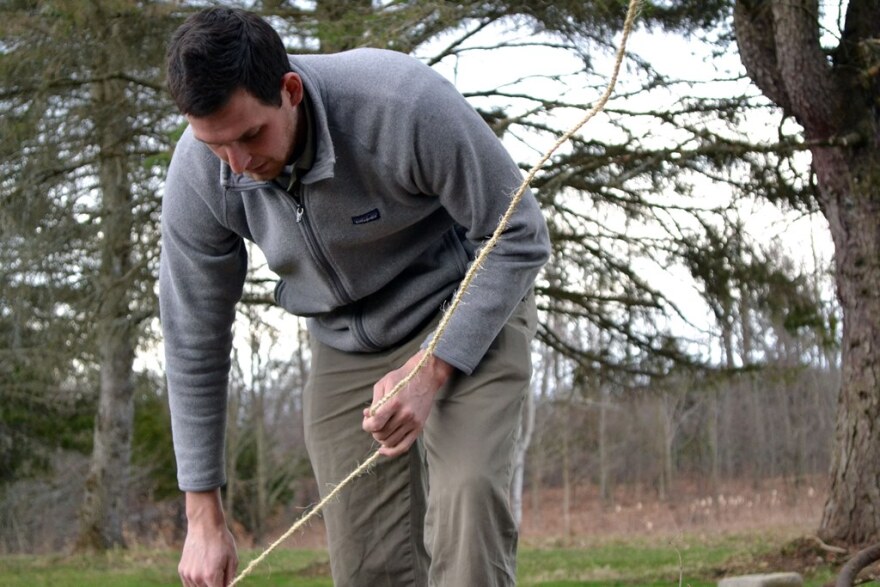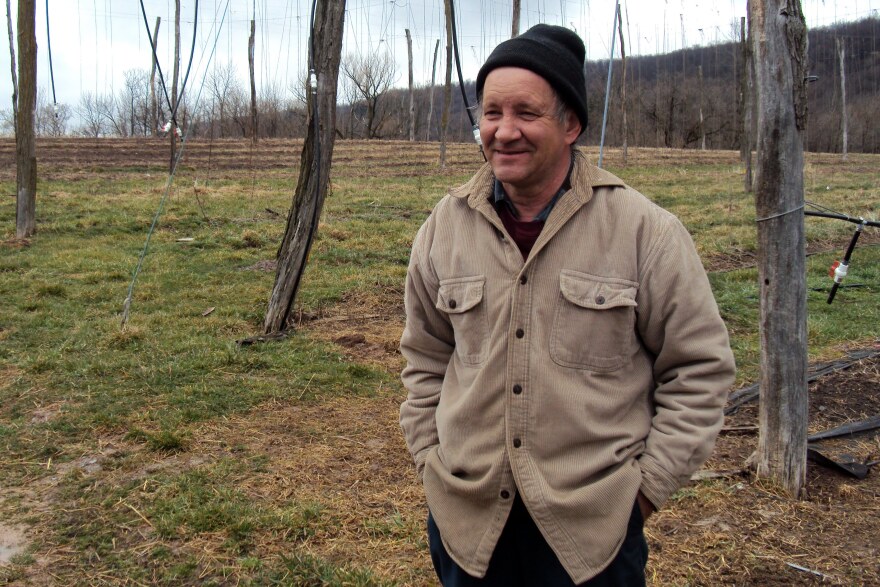Dave Pasick moved back to his family’s farm just north of Utica a few years ago, naming it Szaro Farms, after an old family name.
Last year, behind the old barn where a silo once stood, he found plants climbing up the side of its old frame.
"They were all over the barn and we were like, 'oh man, those are hops,'" Pasick recalls.So last summer he strung some ropes up to the side of the barn so the plants, known as bines, would grow properly.
It’s April now and this year’s hops haven’t yet started popping out of the ground, but he’s getting ready. He recently spent a chilly, damp morning climbing up the inside of the barn, tying more rope for the hops to grow along.

Hop bines will grow 18 feet in a year, producing flower-like cones. They’re added to beer for bitterness and flavor.
Pasick has transplanted some of those wild hops and is working on a trellis system to expand the farm. Hop farming right now is more a hobby, but he’s glad to be back on land that’s been in his family for decades.
"I guess in practice, I’m a brand new farmer," Pasick says. "But it’s in my blood. I think I’ll figure it out."
Local beer, local hops
Pasick’s farm turned out about five pounds of hops last year. He was able to sell them to the Saranac brewery down the road in Utica for a special fall beer using all local hops. Pasick proudly outspent what he received for that crop, buying up bottles of Saranac’s Wet Hop brew with his hops in it.
Saranac is just one of the brewers turning to local farms to find ingredients. And that relationship between brewer and farmer is poised to grow.
When the State Legislature passed a bill last year to support New York’s burgeoning craft brewing industry, it put in requirements about the ingredients brewers use. In order to qualify for the state’s financial incentives, brewers must get 20 percent of their hops from here in New York. That requirement will eventually rise to 90 percent by 2025.
"The hop industry is growing at the same rate that the brewing industry is," says Steve Miller, an expert on the plant with the Cornell Cooperative Extension. He leads the recently formed Northeast Hop Alliance.
A century ago central New York produced the majority of the nation’s hops. But by the 1950's hop growing had moved to the Pacific Northwest. While most hops are still grown out there, Miller says hops in New York are making a strong comeback, thanks to farmers like Pasick.
"If you can imagine saying all of the sudden somebody invented strawberries and everybody in the state wanted to have a strawberry farm, that’s essentially what’s happening with hops," Miller says.
He says a decade ago there were only 10 acres of hops being grown in New York. By this summer, that will have increased 10 fold.
Foothills
On a foggy morning Larry Fisher is showing me around Foothill Farms in the Madison County town of Munnsville.
He points out some plants just poking out of the ground, called a hill in hop lingo. These early shoots will be cut back to encourage the growth of stronger bines, Larry explains. By the end of the summer they’ll tower high above on a network of ropes.

Larry and his wife Kate are now some of the more experienced hop farmers in central New York. They began planting hops in 2001 after Kate became fascinated with the plant.
Being amongst the first to start growing hops again, Kate says they had to adapt some of the early advice they got.
"We planted things too close together when we started. The rows were seven feet apart based on readings of hop history, not thinking that a tractor is a little bit wider than a horse," she recalls with a laugh.
The Fishers now grow several varieties of hops on about seven acres.
Come late August they'll harvest the hop bines. They’ll cut down the lengthy plants and run them through a harvester that Larry built himself.
The Fisher's hops and others grown in New York will be accenting local beers hitting bar taps a few months later.






